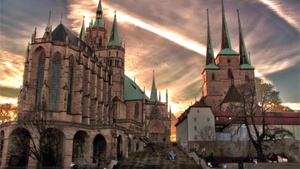Matthias Geitel. Tour
In the organizer's words:
In 1996, the artist Matthias Geitel, who was still living in Erfurt at the time, traveled to the Italian town of Olevano Romano, a small town east of the capital Rome, for the Casa Baldi scholarship. The hostel called Casa Baldi became famous in the 19th century for European artists who traveled to Rome for their studies and spent the summer in the mountains, always on the move - on foot or riding a mule.
Matthias Geitel explored this tradition, which has corresponded with the longing for Italy among German artists and intellectuals since the 18th century, but also with the tourism to Italy that has become fashionable among (West) Germans since the 1960s. Following strict conceptual guidelines, he drew postcards of Rome and its surroundings ("Betrachtungen über das Gerinnen der Form - Olevano Romano / Italien") and sent some of them to addresses in his home country. On October 21, 1996, he set off early in the morning on foot in the direction of Rome. With only a map of Lazio and a map of Rome in his luggage, he marched from the Olevano hill down into the Campagna and along the often narrow or non-existent shoulder of the highway, always heading west, towards Rome's main train station. At certain intervals, he documented his journey with his camera. This resulted in around 100 slides of the roads between Olevano and Rome Termini. He earned astonished looks from locals and, at the end of the 56 km route, open heels and total exhaustion. But in 1997, he also produced the artist's book "A Hike through the Campagna", which combined the drawings from postcards, the photos of the hike and the experiences and reflections of his stay in Olevano noted in his diary with references to art history.
The artist writes about other fruits of his hike through the Campagna:
"Walking through the Roman Campagna with a sharp pencil and paper is how one would like to imagine the life of German artists in the first half of the 19th century. I also walked there once, in keeping with the times, with a camera in my hand to capture the views towards Rome. I didn't find an idyllic landscape of emptiness and I wasn't in the mood for a romantic drawing. I wanted to follow a fixed route, document it and satisfy a certain curiosity.
15 years later, I made a drawing of this tour on the occasion of the exhibition 'Seeing Rome and Dying ...' in the Erfurt Kunsthalle. It was a welcome opportunity to recall my Roman hike from 1996 and to reconstruct and record the route I had taken back then. The Campagna line became the model for a series of nine drawings of this kind, all of which are around 170 cm wide and show the shapes of the paths I took." He has always documented these paths using photographic means.
A selection of the lines associated with his walks are at the center of the exhibition: Olevano Romano - Rome (1996), Rome - Cervara (2012), Cerveteri (2012), Pompeii - Herculaneum (2015), Venice (2017). The photographic documentation ("path photos") of three hikes will also be presented on screens. The artist is also showing a group of watercolors from the Knäuel series.
Since 1996, he has been focusing on landscapes, signs, skulls and net structures with the project "Variations of the simple line" in order to abstract them strongly using graphic means. These drawings are reduced to the meeting of a few lines and the empty spaces between them. The most recent watercolors in the Knäuel series are also concerned with the drawing and networking of single or double arcs, whereby the free flow of the pigments, their controlled deposition on the paper and the deliberate design of painterly surfaces take on increasing importance.
An artist's book accompanies the current exhibition. Matthias Geitel's connection to Friedrich Nerly's art-historical legacy of landscape painting in the 19th century and to the phenomenon of German travel artists in Italy is particularly clear in the texts and pictures, some of which are also collages.
This content has been machine translated.










